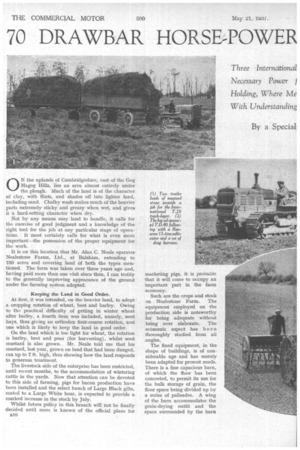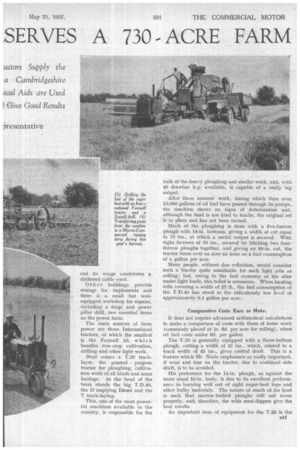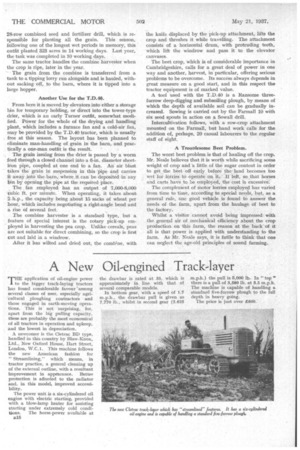70 DRAWBAR HORSE-POWER SERVES A 730 ACRE FARM
Page 50

Page 51

Page 52

If you've noticed an error in this article please click here to report it so we can fix it.
Three International Necessary Power j Holding, Where Me With Understanding 'actors Supply the a Cambridgeshire ical Aids are Used Give Good Results By a Special: kesentative
0 N the uplands of Cambridgeshire, east of the Gog Magog Hills, lies an area almost entirely under the. plough. Much of the land is of the character of clay, with flints, and shades off into lighter land, including sand. Chalky wash makes much of the heavier parts extremely sticky and greasy when wet, and gives it a hard-setting character when dry.
Not by any means easy land to handle, it calls for the exercise of good judgment and a knowledge of the right tool for the job at any particular stage of operations. It most certainly calls for what is even more important—the possession of the proper equipment for the work.
It is on this location that Mr. Alan C. Neale operates, Nealestone Farms, Ltd., at Balsham, extending to 730 acres and covering land of both the types mentioned. The farm was taken over three years ago and, having paid more than one visit since then, I can testify to the generally improving appearance of the ground under the farming system adopted.
Keeping the Land in Good Order.
At first, it was intended, on the heavier land, to adopt a cropping rotation of wheat, beet and barley. Owing to the practical difficulty of getting in winter wheat after barley, a fourth item was included, namely, seed hays, thus giving an orthodox four-course rotation, and one which is likely to keep the land in good order.
On the land which is too light for wheat, the rotation is barley, beet and peas (for harvesting), whilst seed mustard is also grown. Mr. Neale told me that his mustard, last year, grown on land that had been dunged, ran up to 7 ft. high, thus showing how the land. responds to generous treatment.
The livestock side of the enterprise has been restricted, until recent months, to the accommodation of wintering Cattle in the yards. Now that attention can be devoted to this side of farming, pigs for bacon production have been installed and the select bunch of Large Black gilts, mated to a Large White boar, is expected to provide a marked increase in the stock by July.
Whilst future policy in this branch will not be finally decided until more is known of the official plans for n16 marketing pigs, it is probable that it will come to occupy an important part in the farm economy.
Such are the crops and stock on Nealestone Farm. The equipment employed on the production._ side is noteworthy for being adequate without being over elaborate. The economic aspect has been thoroughly studied from all angles.
The fixed equipment, in the shape of buildings, is of considerable age and has merely been adapted for present needs. There is a fine capacious barn, of which the floor has been concreted, to permit its use for the bulk storage of grain, the floor space being divided up by a series of palisades. A wing of the barn accommodates the grain-drying outfit and the space surrounded by the barn and its wings constitutes a sheltered cattle yard.
Other buildings provide storage for implements and there is a small but wellequipped workshop for repairs, including a forge and power pillar drill, two essential items on the power farm.
The main sources of farm power are three International tractors, of which the smallest is the Farmall 10, which handles row-crop cultivation, drilling and other light work.
Next comes a T.20 tracklayer, the general purpose tractor for ploughing, cultivation work of all kinds and some haulage. At the head of the team stands the big T.D.40, the D implying Diesel and the T track-laying.
This, one of the most powerful machines available in the country, is responsible for the bulk of the heavy ploughing and similar work, and, with40 drawbar h.p. available, is capable of a really big output.
After three seasons' work, during which time over 10,000 gallons of oil fuel have passed through its pumps, the machine shows no signs of deterioration and, although the land is not kind to tracks, the original set is in place and has not been turned.
Much of the ploughing is done with a five-furrow plough with 14-in, bottoms, giving a width of cut equal to 70 ins., at which a useful output is secured. With eight furrows of 10 ins., secured by hitching two fourfurrow ploughs together, and giving an 80-in, cut, the tractor turns over an acre an hour on a fuel consumption of a gallon per acre.
Many people, without due reflection, would consider such a la-actor quite unsuitable for such light jobs as rolling; but, owing to the fuel economy of the oiler under light loads, this belief is erroneous. When hauling rolls covering a width of 27 ft., the fuel consumption of the T.D.40 has stood at the ridiculously low level of approximately 0.1 gallon per acre..
Comparative Costs Easy to Make.
It does not require advanced arithmetical calculations to make a comparison of costs with those of horse work (commonly placed at 1s. 6d. per acre for rolling), when oil fuel costs under 6d. per gallon.
The T.20 is generally equipped with a three-bottom plough, cutting a width of 42 ins., which, related to a track width of 43 ins., gives central draft. This is a feature which Mr. Neale emphasizes as really important, if wear and tear on the tractor, due to continual side draft, is to be avoided.
His preference for the 14-in, plough, as against the more usual 10-in, body, is due to its excellent performance in burying well out of sight sugar-beet tops and other bulky materials. The nature of much of his land is such that narrow-bodied ploughs will not scour properly, and, therefore, the wide semi-diggers give the best results.
An important item of equipment for the T.20 is the B17
28-row combined seed and fertilizer drill, which is responsible for planting all the grain. This season, following one of the longest wet periods in memory, this outfit planted 323 acres in 14 working days. Last year, the task was completed in 10 working days.
The same tractor handles the combine harvester when the crop is ripe, later in the year.
The grain from the combine is transferred from a tank to a tipping lorry run alongside and is hauled, without sacking off, to the barn, where it is tipped into a large hopper.
Another Use for the T.D.40,.
From here it is moved by elevators into either a storage bin for temporary holding, or direct into the tower-type drier, which is an early Turner outfit, somewhat modified. Power for the whole of the drying and handling plant, which includes a furnace fan and a cold-air fan, may be provided by the T.D.40 tractor, which is usually free at this season. The layout has been planned to eliminate man-handling of grain in the barn, and prac
tically a one-man outfit is the result. '
The grain issuing from the drier is passed by a worm feed through a closed channel into a 6-in, diameter sheetiron pipe, coupled at one end to a fan. An air blast takes the grain in suspension in this pipe and carries it away into the barn, where it can be deposited in any bin by opening the pipe lat the requited place.
The fan employed has an output of 7,000-8,000 Cubic ft. per minute. When operating, it takes about h.p., the capacity being about 15 sacks of wheat per hour, which includes negotiating a right-angle bend and a rise of several feet.
The combine harvester is a standard type, but a feature of special interest is the rotary pick-up employed in harvesting the pea crop. Unlike cereals, peas are not suitable for direct combining, so the crop is first cut and laid in a windrow.
After it has wilted and dried out, the combine, with the knife displaced by the pick-up attachment, lifts the crop and threshes it while travelling. The attachment consists of a horizontal drum, with protruding teeth, which lift the windrow and pass it to the elevator canvases.
The beet crop, which is of considerable importance in Cambridgeshire, calls for a great deal of power in one way and another, harvest, in particular, offering serious problems to be overcome. Its success always depends in great measure on a good start, and in this respect the tractor equipment is of marked value.
A tool used with the T.D.40 is a Ransome three furrow deep-digging and subsoiling plough, by means of which the depth of available soil can be gradually increased. Sowing is carried out by the Farman 10 with six seed spouts in action on a Sowall drill.
Intercultivation follows, with a row-crop attachment mounted on the Farina, but hand work calls for the addition of, perhaps, 20 casual labourers to the regular staff of eight.
A Troublesome Beet Problem.
The worst beet problem is that of hauling off the crop. Mr. Neale believes that it is worth while sacrificing some weight of crop and a little of the sugar content in order to get the beet • off early before the land becomes too wet for lorries to operate on it If left, so that horses and carts have to be employed, the cost is excessive.
The complement of motor lorries employed has varied from time to time, according to special needs, but, as a genera/ rule, one good vehicle is found to answer the needs of the farm, apart from the haulage of beet to the factory.
Whilst a visitor cannot avoid being impressed with the general air of mechanical efficiency about the crop production on this farm, the reason at the back' of it all is that power is applied with understanding to the farm. As Mr. Neale says, it is futile to think that one can neglect the age-old principles of sound farming.




































































































